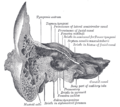| Facial canal | |
|---|---|
 Route of facial nerve, with facial canal labeled | |
 View of the inner wall of the tympanum. (Facial canal visible in upper left; promontory labeled at center) | |
| Details | |
| System | Skeletal |
| Nerve | Facial nerve (CN VII) |
| Identifiers | |
| Latin | canalis nervi facialis, canalis facialis |
| TA98 | A02.1.06.009 |
| TA2 | 688 |
| FMA | 54952 |
| Anatomical terminology | |
The facial canal (also known as the Fallopian canal) is a Z-shaped canal in the temporal bone of the skull. It extends between the internal acoustic meatus and stylomastoid foramen. It transmits the facial nerve (CN VII) (after which it is named).


